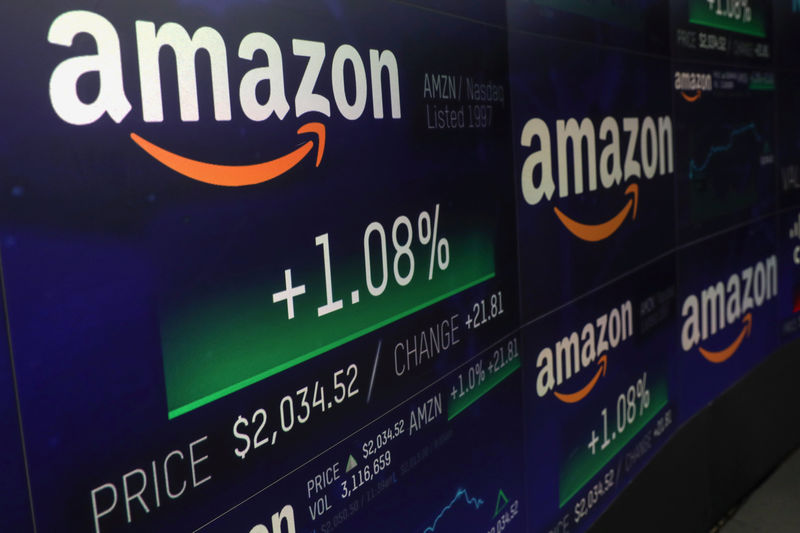Street Calls of the Week
On Friday, Goldman Sachs reiterated its Buy rating and a $255.00 price target for Amazon.com (NASDAQ:AMZN), currently trading at $178.41, as the firm’s analyst Eric Sheridan provided insights into the potential financial impact of the new tariffs introduced by President Trump on April 2. With a market capitalization of $1.89 trillion and robust EBITDA of $120.47 billion, Amazon maintains a strong financial position. Sheridan’s analysis suggests that Amazon’s first-party (1P) eCommerce business could face an annualized EBIT impact ranging from $5 billion to $10 billion due to increased merchandise costs.InvestingPro analysis reveals Amazon’s exceptional financial health with a "GREAT" overall score, suggesting strong resilience to market challenges. For detailed insights and 12 additional ProTips about Amazon’s performance, explore InvestingPro’s comprehensive analysis.
The tariffs, with a weighted average of 18.2%, include a 10% baseline and vary by individual country. Despite the potential increase in costs for Amazon, which currently maintains an 11% year-over-year revenue growth and healthy profit margins, Sheridan highlighted the company’s ability to mitigate these effects through various strategies. Potential mitigating actions include negotiating with vendors to share the burden of higher input costs, adjusting prices on certain items for customers, and shifting the mix of vendors and products sold on the platform to those facing lower tariffs or to US domestic alternatives.
Sheridan also pointed out that Amazon’s worldwide merchandise margin remained relatively stable during the initial series of tariffs implemented during Trump’s first term in 2018-2019. This historical data, though based on estimates and not company-disclosed financials, is considered a reference point for how Amazon might manage the net impact of increased input costs.
It is important to note that the analysis focuses solely on Amazon’s 1P Online Stores business and does not account for any potential impact on Amazon’s third-party (3P) business. In the 3P segment, Amazon does not bear merchandise cost exposure, but there could still be revenue volatility if sellers adjust their prices in response to their own cost increases.
Additionally, the closure of the de minimis exemption for China is likely to reduce competitive intensity. This exemption had previously benefited China-based exporters such as Temu and TikTok Shop, who will now face significant tariffs, potentially altering the competitive landscape. According to InvestingPro data, Amazon’s strong market position is reflected in analysts’ bullish consensus, with a notably low P/E ratio relative to near-term earnings growth. Get access to Amazon’s detailed Pro Research Report, part of InvestingPro’s coverage of 1,400+ top US stocks, for comprehensive analysis and actionable insights.
In other recent news, Amazon’s Project Kuiper is set to launch its first full-scale batch of broadband satellites, a significant step toward providing global high-speed internet. The mission, KA-01, will deploy 27 satellites from Cape Canaveral, with plans for over 3,200 satellites to form the initial constellation. Meanwhile, Amazon’s stock was recently reaffirmed with an Outperform rating by Mizuho (NYSE:MFG) Securities, maintaining a price target of $285. This follows a survey indicating some softening in AWS customer sentiment due to macroeconomic factors, though growth forecasts remain unchanged.
Additionally, Amazon’s Wondery has partnered with Patreon to offer select podcasts on the platform, enhancing fan interaction and exclusive content access. In other developments, IonQ announced the availability of its Forte Enterprise quantum computer on Amazon Braket, marking a collaboration with AWS to expand quantum computing accessibility. This move is expected to facilitate applications across various industries, including life sciences and financial services.
Lastly, Amazon experienced a significant market value decrease after a tech stock sell-off triggered by new tariffs, closing below the $2 trillion mark. Despite these challenges, Amazon continues to pursue strategic initiatives and partnerships, reinforcing its position in the tech and services sectors.
This article was generated with the support of AI and reviewed by an editor. For more information see our T&C.
